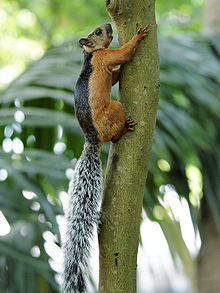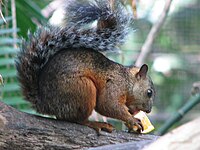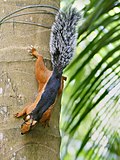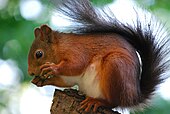
The eastern gray squirrel, also known, particularly outside of North America, as simply the grey squirrel, is a tree squirrel in the genus Sciurus. It is native to eastern North America, where it is the most prodigious and ecologically essential natural forest regenerator. Widely introduced to certain places around the world, the eastern gray squirrel in Europe, in particular, is regarded as an invasive species.

Bornaviridae is a family of negative-strand RNA viruses in the order Mononegavirales. Horses, sheep, cattle, rodents, birds, reptiles, and humans serve as natural hosts. Diseases associated with bornaviruses include Borna disease, a fatal neurologic disease of mammals restricted to central Europe; and proventricular dilatation disease (PDD) in birds. Bornaviruses may cause encephalitis in mammals like horses or sheep. The family includes 11 species assigned to three genera.

The genus Sciurus contains most of the common, bushy-tailed squirrels in North America, Europe, temperate Asia, Central America and South America.

Abert's squirrel or the tassel-eared squirrel is a tree squirrel in the genus Sciurus native to the southern Rocky Mountains from the United States to the northern Sierra Madre Occidental of Mexico, with concentrations found in Arizona, New Mexico, and southwestern Colorado. It is closely associated with, and largely confined to, mature ponderosa pine forests. It is named in honor of the American naturalist John James Abert; nine subspecies are recognised. It is recognizable by its tufted ears, gray color, pale underparts and rufous patch on the lower back. The squirrel feeds on the seeds and cones of the Mexican pinyon and the ponderosa pine when they are available, but will also take fungi, buds, bark, and carrion. Breeding normally occurs in summer, with a spherical nest being built high in the canopy.

The southern Amazon red squirrel, is a squirrel species from South America where it inhabits forests in much of north-western South America east of the Andes. Three subspecies are currently recognised. It is a dark red colour, or a dark brown grizzled with ochre, has whitish underparts and grows to a total length of 48 to 63 cm, including a very long tail. It spends much of its time on the ground in the undergrowth and feeds largely on nuts. Little is known of its breeding habits, but it is a sociable species, several individuals often feeding together in one tree. This squirrel faces no particular threats, has a wide range and is relatively common, and the International Union for Conservation of Nature lists it as a "least-concern species".

Microsciurus or dwarf squirrels is a genus of squirrels from the tropical regions of Central and South America.

The fauna of Nicaragua is characterized by a very high level of biodiversity. Much of Nicaragua's wildlife lives in protected areas. There are currently 78 protected areas in Nicaragua, covering more than 22,000 square kilometers (8,500 sq mi), or about 17% of its landmass.

The long-tailed manakin is a species of bird in the family Pipridae native to Central America where it inhabits both wet and dry tropical and subtropical forests. It is a small, plump bird about 10 centimetres (4 in) long. Males have black plumage with a blue back and a red crown, and the two central tail feathers are greatly elongated. Females and juveniles are olive-green with paler underparts. At breeding time, males are involved in a cooperative lekking behaviour with a complex coordinated courtship dance. This is a fairly common species with a wide range, and the International Union for Conservation of Nature has rated its conservation status as being of "least concern".
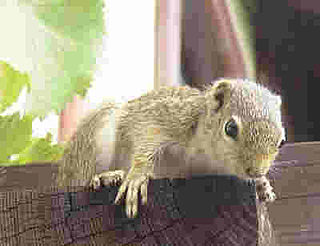
The Gambian sun squirrel is a species of rodent in the family Sciuridae. It is found in Angola, Benin, Burkina Faso, Central African Republic, Chad, Democratic Republic of the Congo, Ivory Coast, Eritrea, Ethiopia, Gambia, Ghana, Guinea, Guinea-Bissau, Kenya, Liberia, Nigeria, Senegal, Sierra Leone, Sudan, Tanzania, Togo, Uganda, and Zambia. Its natural habitat is wooded savanna.
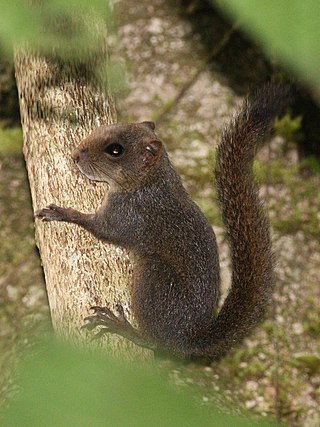
The Central American dwarf squirrel, also known as Alfaro's pygmy squirrel, is a small tree squirrel in the genus Microsciurus and tribe Sciurini found in Colombia, Costa Rica, Nicaragua, and Panama. No species of squirrel within this genus are listed as endangered, however they are rarely seen because they are extremely elusive. This suggests that their population numbers may be larger than documented.
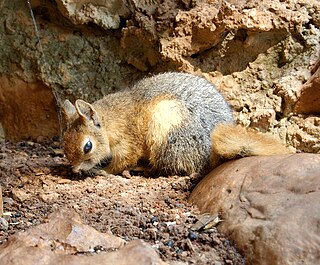
The Caucasian squirrel or Persian squirrel, is a tree squirrel in the genus Sciurus found in temperate broadleaf and mixed forests in south-western Asia.

Deppe's squirrel is a species of tree squirrel in the genus Sciurus native to Belize, Costa Rica, El Salvador, Guatemala, Honduras, Mexico, and Nicaragua.

The red-tailed squirrel is a species of tree squirrel distributed from southern Central America to northern South America.

Peters's squirrel is a tree squirrel in the genus Sciurus endemic to Mexico. It was first described by the German naturalist and explorer Wilhelm Peters in 1863. Three subspecies are recognised. It is a common species, and the IUCN has rated its conservation status as being of "least concern".

The Andean squirrel is a tree squirrel endemic to Colombia where it inhabits montane rain forest and cloud forests of the Cordillera Occidental and Cordillera Central ranges of the Colombian Andes, at elevations between 2,000 and 3,300 metres. It is a small species with a body length of about 14 cm (6 in) and a similar length tail. It has soft, silky, reddish-brown fur, a darker tail and yellowish-grey underparts. It is thought to be diurnal but has been little studied, and the International Union for Conservation of Nature has rated its conservation status as being data deficient.

Richmond's squirrel is a poorly known tree squirrel in the genus Sciurus endemic to Nicaragua, which is likely a synonym of the red-tailed squirrel. It is locally known as the ardilla del rama.

The Yucatan squirrel, originally named the Yucatan gray squirrel, also once named the Campeche squirrel, is a tree squirrel in the genus Sciurus found in the Yucatán Peninsula and adjacent areas. It is native to northern Belize, northeastern Guatemala, and southeast Mexico.

The tropical ground squirrel is a species of rodent in the family Sciuridae. At one time the species was originally described as Spermophilus adocetus, but the genus Spermophilus was revised and subdivided in 2009 and it was placed in the genus Notocitellus. It is endemic to arid upland areas and deciduous woodland in Mexico. It is locally referred to as Cuinique.
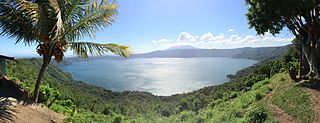
Laguna de Apoyo Nature Reserve is a nature reserve located between the departments of Masaya and Granada in Nicaragua. Lake Apoyo was declared a nature reserve in 1991 and is managed by the Ministry of the Environment and Natural Resources (MARENA) and comprises one of 78 protected areas of Nicaragua. Activities within the Laguna de Apoyo Nature Reserve are regulated by its management plan, approved in 2010, which prohibits the construction of housing within the reserve and use of motorized vehicles on the lake. Geological data suggests that Lake Apoyo originated about 23,000 years ago.

The Central American banded gecko is a species of moderately-sized gecko in the genus Coleonyx, native to Central America and first identified by Wilhelm Peters in 1863. It is a member of the eyelid geckos.
